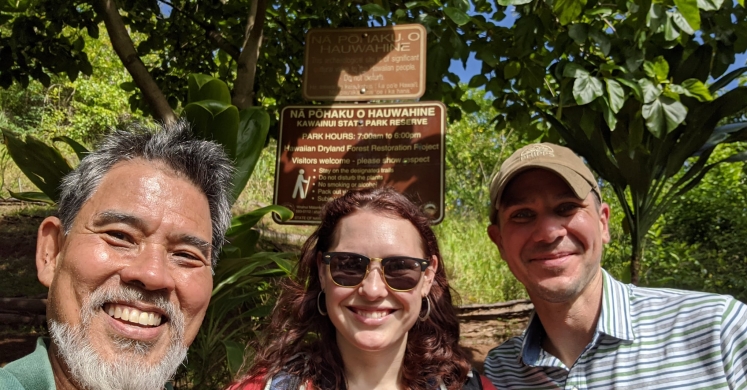Blog

Aloha from Hawaii
As part of the three-year planning and design process behind our upcoming Tropical Forest exhibit, Julianna Razryadov and Adam Haas are traveling to Hawaii to study first-hand the region’s biodiversity hotspots, natural resources and culture. Follow their adventures!
Our first full day in Hawaii was a deluge of information. Our first stop was the Bishop Museum, Hawaii’s State Museum of Natural and Cultural History. This beautiful museum holds within its walls artifacts stretching from stone adze heads to intricate chief’s capes made of bird feathers. Side note – we learned that the feathers harvested for these capes from birds that were captured and then released after having a few feathers taken. This story goes a long way to show the level of respect that Hawaiians have for nature and the extraction of resources. You may take what you need, but only with permission and respect for what is giving that to you.
Following an incredibly detailed combing of the museum, we had lunch of our first taste of poi, a side dish of mashed taro often served alongside shredded pork which we also partook in, purple sweet potato, and haupia – a coconut milk gelatin pudding. This was our first experience of traditional Hawaiian cuisine and boy were we not disappointed. Well, to be completely honest, poi is an acquired taste.
Next we headed out to Nā Pōhaku o Hauwahine, a reserve restored to native, endemic, and pre-contact plants. This land is taken care of by ‘Ahahui Mālam’a i ka Lōkahi. Let’s break that down.
‘Ahahui means group
Mālam’a means take care
ka means of
Lōkahi means balance
The group that takes care of the balance. It’s an incredibly beautiful sentiment.
The reason we went there was to meet Dr. Sam Gon. Sam is a senior scientist for the Nature Conservancy. He is a cultural advisor. He furthered Indigenous rights and recognition at the IUCN by proposing and getting passed motion 83 which affirms the role of Indigenous cultures in global conservation. He is on the board of countless organizations and a prominent voice for biocultural conservation. He is also a chant and hula practitioner.
Sam led us through this reserve, on whose board he used to sit, and talked plants and Hawaiian stories. We learned that Hawaiians use the ‘ilieo (Plumbago zeylanica) to burn a mark into the skin for a temporary tattoo – a test run before you make a decision. We learned about the wiliwili tree (Erythrina sandwicensis), one of the few Hawaiian deciduous trees – it drops its leaves in the dry season. Sam not only knows Hawaii, he respects the land. He regards it as a friend, as an elder. As we climbed to the top of the hill of the preserve, Sam revealed to us that the caretaking group had asked him to write a chant to honor this place. I asked permission to film him so that I can bring this gift to you.
At the end of our first full day in Hawaii we are overwhelmed with the wealth of this place and absolutely energized to dig deeper, learn more, and really experience this center of magic and wisdom.
Select photos © Julianna Razryadov and Paul g. Wiegman

